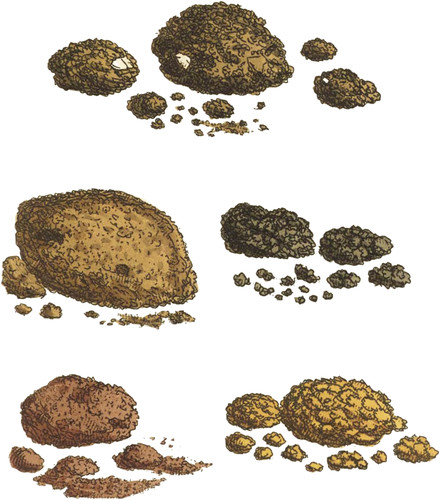 Enlarge
Enlarge
British Mineralogy
Moulds
The genius of our country, often so happily exerted in agricultural pursuits, has yet much to do in regard to one of the first sources of vegetation; I mean the Mineral Kingdom or Department, which assists vegetation, the link of life, and support of the Animal Kingdom, The example of old ground not requiring manuring is not common. I am glad here to show one in the upper figure, which represents Mould from Wilson field near High Wycomb, Bucks, which produces regularly fine crops of wheat without manure, and had so done for eighteen years in June 1801, when Mr, Allen gave me the specimen, It may be remarked, that among some hundred kinds which I have examined, I have not seen one exactly resembling it, and therefore I presume to hope that external characters may be of more importance in this subject than has hitherto been suspected. It is evidently mixed with Chalk in little pieces. The Silex seems to be in very small grains held together by common Clay and vegetable Mould.
The right hand figures are from Orcheston St. Mary, about two miles from Salisbury, famous for producing extraordinary crops of Long grass. Excluding the small bed of loose pebbles, which is a common washed gravel found beneath, I have figured the Mould as it is immediately connected with the roots of the plants, an inch or two in depth. It seems to be fine sand, held together by Clay mixed with fine dirty Chalk and vegetable remains, some parts full of roots and others more detached and easily separated. Its situation allows of much water occasionally, which of course fertilizes it; but it has still a different appearance from any other Earth I have met with. The detached pieces adhere rather strongly, and are rather hard to break; a character which I have known brick-makers to call water-bound. I believe it to be a vegeto-carbonaceous binding, if I may term it so.
The next left hand figure is a soil from Shrewsbury with which I was favoured by Colonel Green. Its peculiar appearance caused it to be noticed. It is a very fine, but looser Earth than either of the former; perhaps has less common Clay, and it appears to show more Chalk with Silicious pebbles; and it connects its particles so as to leave hollow interstices, although often in largish fragments. It produces good wheat, barley, &c. The lower right hand figure is of a fine Earth for Oaks from Lord Fitzwilliam’s fine Oak-park about nine miles from Sheffield, Yorkshire. It is a light ochraceous Loam, chiefly Clay and fine Sand coloured by a lightish Oxide of Iron with some vegetable Earth. It is remarkable for an astringent bitter taste, resembling Bark. The largest Oaks in Great Britain are found in this park. The left hand lower figure represents a Mould brought from near Bridgenorth in Shropshire by my friend Mr. Charles Stokes. It is reputed as very fertile for Barley and Wheat, and for retaining moisture when most of the neighbouring lands are dry and sterile. There is a remarkable gravel terrace near it. The red appearance with a peculiar softness in the aspect makes it noticeable. It is mostly Sand mixed with Clay and Red Oxide of Iron, and does not seem to have much Lime or Vegetable Matter among it.
The analyses of Vegetable Earths, &c, are well treated of in many books, particularly Kirwan’s Essay on Manures, and H. Davy, Esq., for the Board of Agriculture. It is, however, desirable to gain as much knowledge as sre can of a soil by figures and practice also; otherwise we cannot compare one soil with another, or the part of a soil analysed with the land from which it is taken.
Lapidaries guess pretty well of hard Stones by sight with practice, so should those concerned in agriculture. Indeed it would be very convenient if we could compare a written analysis, for instance, soil taken from Sheffield Place, remarkable for producing flourishing Oaks, analysed by Davy, and found to consist of
| Water | 3 |
| Silex | 54 |
| Alumine | 28 |
| Carbonate of Lime | 3 |
| Oxide of Iron | 5 |
| Decomposing matter | 4 |
| Loss | 3 |
| 100 |
and the Oak soil figured from Yorkshire: we might conceive the five parts of Oxide of Iron to give the colour; the Silex grittiness; the Clay unctuosity; the Lime taking a part from its unctuosity as well as the Sand; the Vegetable a soft matter distinguished from both by a rotten and carbonaceous appearance. According to experience, his Oak land would to me differ in being a little lighter-coloured, having a little more chalky whiteness, or having a little more Lime than ours contains, and perhaps being of a finer grain. This may be learned best by experience; analysis may prove it.

